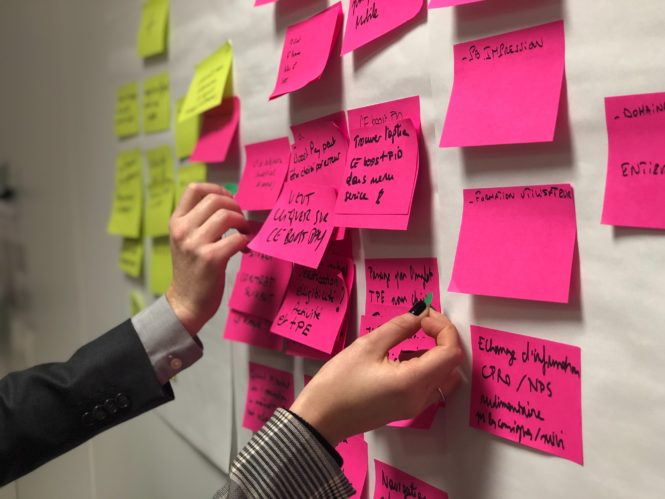
Introduction
Design thinking is a customer centric approach putting the customer at the heart of the analysis to understand what they really need and uses techniques that focus on understanding them. This helps to innovate and generate new ideas. Your customers may well be the people in your workshop. Customer can mean the people who are benefitting from the work you are doing for them.
I regularly use design thinking techniques in my workshops to address 3 common problems.
These are:
- Understanding the context and rationale
- Getting everyone to contribute and encouraging interactivity
- Establishing priority without everything being a must have
I will take each one of these problems in turn and explain how design thinking can help.
Understanding the context and rationale
The techniques in design thinking are based on trying to understand the customer and their pain points. This is to ensure the real problem is going to be resolved rather than relying on one solution being presented. Narrowing down to one solution too soon prevents other options from being explored that could be a better fit. Not understanding the context can make it difficult to understand the problems trying to resolve.
Design thinking techniques help to ensure:
- The context is clearly understood,
- How a solution will resolve that problem
- What it means to the customer.
Without understanding these it would be difficult to measure the impact of any proposed solution and whether it is the best solution.
A technique I will use as an example is called the customer journey. This is where the attendees all map out on post it notes the journey a customer takes from the trigger that starts making them think about interacting with the product or service up to when they have brought or used it and any after sales experiences they have. The focus is on the touchpoints your product or service has with the customer.
Aim for between 9-16 stages in the journey map. Then use this as a basis for discussing insights into each stage of the journey highlighting any areas that cause problems for the customer. This really helps to understand the context and the rationale for whatever areas of the customer journey that could be resolved by a solution and the impact it would have. To encourage creativity and help gain a shared understanding pictures can also be drawn rather than just words.
Getting everyone to contribute and encouraging interactivity
Design thinking workshops require lots of post it notes and marker pens so each person can write their thoughts. The technique is simple. Depending upon the objective of the workshop you will be asking each attendee to spend 4 minutes writing in silence and individually the ideas they have based on the question you have asked them. You will the ask the attendees to put their post it notes on the wall. You might then ask the attendees to group the post it notes as a team.
This has the following benefits.
- Everyone has had a voice
- Encourages team work for grouping the post it notes
- Takes pressure off you to capture the ideas raised yourself
I ran a process workshop recently where I wanted to understand all the business processes a team did. If I had tried to capture it all myself, it would have been difficult and time consuming. By asking everyone to write out on separate post it notes all the types of business processes they carried out and then working together to group them captured a large amount of information in one workshop. I was then able to ask them whether they thought anything was missing. It was great because it gave them the chance to step back and review all the post it notes and helped to discuss and give confidence that the business processes had been captured.
Establishing priority without everything being a must have
Ensuring priority is a skill required in business analysis. If everything is specified as a must it can be become impossible to deliver because given time, cost and resource constraints it might not be possible to do everything at once. Changes often must be managed in smaller manageable chunks. There are design thinking techniques that can help with this. Once the post it notes with each person’s contribution are on the wall, they can be revisited by asking the attendees to use different coloured sticky circles to highlight the ones that meet the criteria best based on the questions you ask them.
Questions that can be used as examples are:
- What will bring the biggest benefits?
- What causes the biggest problems?
- What are the quick wins?
- What isn’t a problem?
Limit the number of coloured circle stickies that can be used so not all can be selected. This will bring out the most relevant ones for further discussion. You can choose different colours based on the questions you ask. Make sure you note down what each of the colours represent. This ensures everyone gets a say and encourages their input to explain their views. It also shows areas of common consensus where several stakeholders are voting the same way.
Summary
Design thinking puts customer viewpoints and experience at the heart of the analysis when looking to resolve problems and to design innovative ideas. The focus is on getting information from workshop attendees in a way that generates discussion and produces output which relates to the customers greatest needs. It is great for ensuring full participation and helps to capture the information faster and more accurately than if you were writing just on your note pad.
Thoughts? Questions? Please share in the comments.
If you have found this article useful then you might like my book – The Business Analysis Handbook – Techniques and Questions for better Business Outcomes. The book is available from www.koganpage.com and all major print and e-book retailers.


Good article which is easy to digest.
Helen, you provide an approach that appears simplistic but a powerful and focused output. I am still enjoying learning from you.
Hi Keir,
Thanks, lovely hearing from you. Sounds like you are still doing well. I am talking more about this at Severn Trent in Coventry on the 17th July and at the Business Analysis European conference in September.
Regards, Helen